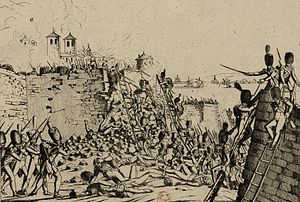Siege of Tarragona (1811)

Storming of Tarragona by the French; Depiction of the 19th century (the German caption is not visible here)
| date | May 3 to June 28, 1811 |
|---|---|
| place | Tarragona , Spain |
| output | Victory of the besiegers |
| Parties to the conflict | |
|---|---|
| Commander | |
| Troop strength | |
| around 20,000 men | up to 11,000 men |
| losses | |
|
unknown |
over 4,000 dead, including at least 2,000 civilians; |
Bailén - Roliça - Vimeiro - Saragossa (1808) - Burgos (Gamonal) - Medina de Rioseco - Espinosa - Tudela - Somosierra - Saragossa (1809) - La Coruña - Torres Vedras - Valls - Braga - Oporto - Talavera - Ocaña - Gerona - Ciudad Rodrigo (1810) - Buçaco - Gévora - Barrosa - Badajoz (1811) - Fuentes de Oñoro - La Albuera - Tarragona (1811) - Sagunto (Murviedro) - Ciudad Rodrigo (1812) - Badajoz (1812) - Majadahonda - Salamanca - García Hernández - Venta del Pozo - Vitoria - Sorauren - San Sebastián - Bidassoa

The siege of Tarragona by French troops occurred on the Iberian Peninsula during the Napoleonic Wars . It began on May 3rd and ended when the besiegers stormed the city of Tarragona on June 28th, 1811.
The siege
The Commander in Chief of the French Army in Aragon , General Louis Gabriel Suchet , was able to provide an army of around 20,000 men for the siege of Tarragona, including 1,400 horsemen, 2,000 artillerymen and 750 engineers. The infantry was divided into three divisions under Generals Habert , Harispe and Frère . Habert's division was sent to Tarragona via Tortosa to cover the siege artillery along the coastal road, while the other two divisions advanced directly on the road from Lerida to Tarragona. Suchet's army arrived at Tarragona on May 2nd and drove the Spanish outposts back to the outer fortifications on May 3rd. It took the French a week to clear up the enemy defenses, organize their troops and artillery, and initiate the fire.
Since May 8th the French began to set up a fortified redoubt with several batteries of 24-pound cannons on the bank, because the English fleet was providing fire protection and supplies to the besieged Spaniards. The squadron under Commodore Codrington then had to retreat to the southern end of the harbor bay on May 13 and could no longer provide effective assistance. On May 27, the French General Salme fell in a storm against Fort Olivo. On May 30th, the Spanish commander General Campoverde convened a council of war in Tarragona and announced that he would leave the city in order to set up a relief army. The following day he left and handed General Juan Contreras supreme command of the city's defense, which consisted of about 8,000 men. Despite all efforts, Campoverde did not manage to collect more than 10,000 men in the Valencia area in the following days.
By June 7, the French had shot the upstream Fort Francoli ready for a storm and reached a breakthrough in the wall within 12 hours, then Contreras withdrew the entire garrison from the fort into the city. The French were finally able to install a heavy gun battery in Fort Francoli and take direct fire on the city walls from June 16. On June 21, the French had made several breaches in the bastions of San Carlos and Orleans. General Contreras had gathered 6,000 men ready to defend the threatened Lower City under the command of General Sarsfield . The fierce fighting of the past few weeks and the sustained resistance encountered by the French invading the city led to a massacre of the city's population on June 29th .
consequences
Success brought Suchet to the position of Marshal of France . The result of the siege was a severe blow to the Spanish resistance in Catalonia , as not only were a large part of the Spanish armed forces operating in this region killed or captured, but one of the most important supply ports was also lost. General Contreras was also captured and interned in the castle of Bouillon. Among the few troops that escaped this fate was a squadron from the Alcántara cavalry regiment under Moritz von Hirschfeld . She escaped from the enclosed fortress the night before the conquest.
literature
- Nick Lipscombe: Wellington's Eastern Front: The Campaign on the East Coast of Spain 1810-1814 , Pen and Sword Books, 2016.
Web links
- Juan Senen de Contreras: Relation of the Siege of Tarragona, and the Storming and Capture of that City by the French, in June, 1811. London 1813. Digitized on Google Books .
- Military History Encyclopedia on the Web: Siege of Tarragona, 3 May-28 June 1811.
References and comments
- ^ A b According to Contreras, Relation , p. 40, the Spanish losses amounted to 6,032 men, including 32 officers. He puts the losses of the French at over 12,000 men - a figure that is certainly too high. Among the fallen French are said to have been a general, 14 colonels who were regimental commanders, and 50 other officers.
- ↑ Jacob Klaus , one of the Palatinate originating voltigeurs of participating in the siege 117. French line regiment, left a vivid account of this massacre. See Joachim Kermann: Palatine under Napoleon's flags. Veterans remember. Experience reports on the occasion of the 200th anniversary of the French Revolution. (= Reprint 6 of the Neustadt district group in the Historisches Verein der Pfalz eV), Neustadt an der Weinstrasse 1989, p. 98ff.
- ↑ It was the current Regimiento de Caballería Acorazado "Alcántara" n.º 10 .
- ↑ See Heinrich von Holleben : Memories of Eugen and Moritz von Hirschfeld from Germany and Spain. Compiled by an 80-year-old veteran of the York Corps of Leib-Regiments. Mittler, Berlin 1863, p. 158.
